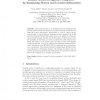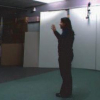141 search results - page 4 / 29 » A differential geometric approach to representing the human ... |
ECCV
2002
Springer
14 years 9 months ago
2002
Springer
Human activity can be described as a sequence of 3D body postures. The traditional approach to recognition and 3D reconstruction of human activity has been to track motion in 3D, m...
HUMO
2007
Springer
14 years 1 months ago
2007
Springer
We describe a “bag-of-rectangles” method for representing and recognizing human actions in videos. In this method, each human pose in an action sequence is represented by orien...
ACCV
2009
Springer
14 years 1 months ago
2009
Springer
The method based on local features has an advantage that the important local motion feature is represented as bag-of-features, but lacks the location information. Additionally, in ...
CVPR
2008
IEEE
14 years 9 months ago
2008
IEEE
In this paper, we present a novel approach for automatically learning a compact and yet discriminative appearance-based human action model. A video sequence is represented by a ba...
IROS
2008
IEEE
14 years 1 months ago
2008
IEEE
— As the ability to produce a large number of small, simple robotic agents improves, it becomes essential to control the behavior of these robots in such a way that the sum of th...


